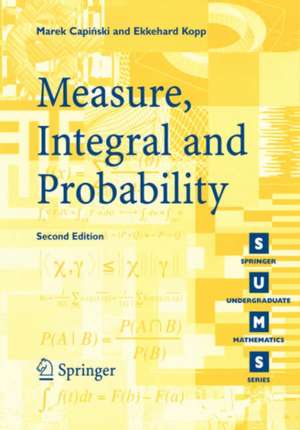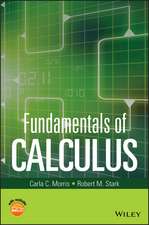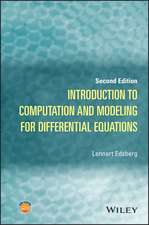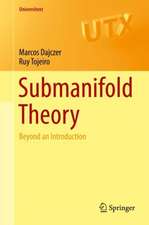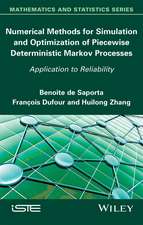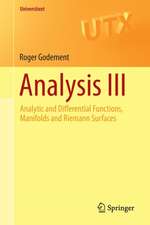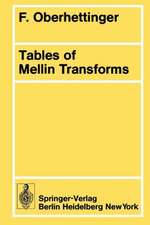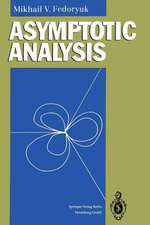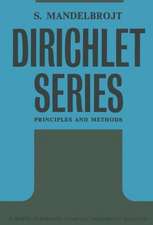Measure, Integral and Probability: Springer Undergraduate Mathematics Series
Autor Marek Capinski, Peter E. Koppen Limba Engleză Paperback – 27 aug 2004
Din seria Springer Undergraduate Mathematics Series
-
 Preț: 350.50 lei
Preț: 350.50 lei -
 Preț: 237.41 lei
Preț: 237.41 lei -
 Preț: 358.82 lei
Preț: 358.82 lei -
 Preț: 237.18 lei
Preț: 237.18 lei -
 Preț: 240.63 lei
Preț: 240.63 lei -
 Preț: 268.37 lei
Preț: 268.37 lei -
 Preț: 224.54 lei
Preț: 224.54 lei -
 Preț: 319.90 lei
Preț: 319.90 lei -
 Preț: 301.10 lei
Preț: 301.10 lei -
 Preț: 236.97 lei
Preț: 236.97 lei -
 Preț: 358.55 lei
Preț: 358.55 lei -
 Preț: 325.20 lei
Preț: 325.20 lei -
 Preț: 221.92 lei
Preț: 221.92 lei -
 Preț: 237.29 lei
Preț: 237.29 lei -
 Preț: 359.15 lei
Preț: 359.15 lei -
 Preț: 265.92 lei
Preț: 265.92 lei -
 Preț: 236.87 lei
Preț: 236.87 lei -
 Preț: 383.17 lei
Preț: 383.17 lei -
 Preț: 229.86 lei
Preț: 229.86 lei -
 Preț: 238.28 lei
Preț: 238.28 lei -
 Preț: 283.11 lei
Preț: 283.11 lei -
 Preț: 239.86 lei
Preț: 239.86 lei -
 Preț: 266.70 lei
Preț: 266.70 lei -
 Preț: 269.99 lei
Preț: 269.99 lei - 15%
 Preț: 526.67 lei
Preț: 526.67 lei -
 Preț: 272.49 lei
Preț: 272.49 lei -
 Preț: 320.20 lei
Preț: 320.20 lei -
 Preț: 265.18 lei
Preț: 265.18 lei -
 Preț: 275.36 lei
Preț: 275.36 lei -
 Preț: 278.24 lei
Preț: 278.24 lei -
 Preț: 272.69 lei
Preț: 272.69 lei -
 Preț: 258.88 lei
Preț: 258.88 lei -
 Preț: 265.83 lei
Preț: 265.83 lei -
 Preț: 266.70 lei
Preț: 266.70 lei -
 Preț: 275.74 lei
Preț: 275.74 lei -
 Preț: 328.08 lei
Preț: 328.08 lei -
 Preț: 265.78 lei
Preț: 265.78 lei -
 Preț: 275.74 lei
Preț: 275.74 lei -
 Preț: 273.45 lei
Preț: 273.45 lei -
 Preț: 277.32 lei
Preț: 277.32 lei -
 Preț: 270.57 lei
Preț: 270.57 lei -
 Preț: 273.63 lei
Preț: 273.63 lei -
 Preț: 270.19 lei
Preț: 270.19 lei -
 Preț: 265.36 lei
Preț: 265.36 lei -
 Preț: 265.36 lei
Preț: 265.36 lei -
 Preț: 268.08 lei
Preț: 268.08 lei -
 Preț: 272.86 lei
Preț: 272.86 lei -
 Preț: 272.69 lei
Preț: 272.69 lei -
 Preț: 271.16 lei
Preț: 271.16 lei -
 Preț: 270.74 lei
Preț: 270.74 lei
Preț: 274.22 lei
Nou
52.48€ • 54.59$ • 43.32£
Carte tipărită la comandă
Livrare economică 14-28 aprilie
Specificații
ISBN-10: 1852337818
Pagini: 328
Ilustrații: XV, 311 p. 3 illus.
Dimensiuni: 178 x 254 x 17 mm
Greutate: 0.52 kg
Ediția:2nd ed. 2004
Editura: SPRINGER LONDON
Colecția Springer
Seria Springer Undergraduate Mathematics Series
Locul publicării:London, United Kingdom
Public țintă
Lower undergraduateCuprins
Content.- 1. Motivation and preliminaries.- 1.1 Notation and basic set theory.- 1.1.1 Sets and functions.- 1.1.2 Countable and uncountable sets in ?.- 1.1.3 Topological properties of sets in ?.- 1.2 The Riemann integral: scope and limitations.- 1.3 Choosing numbers at random.- 2. Measure.- 2.1 Null sets.- 2.2 Outer measure.- 2.3 Lebesgue-measurable sets and Lebesgue measure.- 2.4 Basic properties of Lebesgue measure.- 2.5 Borel sets.- 2.6 Probability.- 2.6.1 Probability space.- 2.6.2 Events: conditioning and independence.- 2.6.3 Applications to mathematical finance.- 2.7 Proofs of propositions.- 3. Measurable functions.- 3.1 The extended real line.- 3.2 Lebesgue-measurable functions.- 3.3 Examples.- 3.4 Properties.- 3.5 Probability.- 3.5.1 Random variables.- 3.5.2 ?-fields generated by random variables.- 3.5.3 Probability distributions.- 3.5.4 Independence of random variables.- 3.5.5 Applications to mathematical finance Proofs of propositions.- 3.6 Proofs of propositions.- 4. Integral.- 4.1 Definition of the integral.- 4.2 Monotone convergence theorems.- 4.3 Integrable functions.- 4.4 The dominated convergence theorem.- 4.5 Relation to the Riemann integral.- 4.6 Approximation of measurable functions.- 4.7 Probability.- 4.7.1 Integration with respect to probability distributions.- 4.7.2 Absolutely continuous measures: examples of densities.- 4.7.3 Expectation of a random variable.- 4.7.4 Characteristic function.- 4.7.5 Applications to mathematical finance.- 4.8 Proofs of propositions.- 5. Spaces of integrable functions.- 5.1 The space L1.- 5.2 The Hilbert space L2.- 5.2.1 Properties of the L2-norm.- 5.2.2 Inner product spaces.- 5.2.3 Orthogonality and projections.- 5.3 The LP spaces: completeness.- 5.4 Probability.- 5.4.1 Moments.- 5.4.2 Independence.- 5.4.3 Conditional expectation (first construction).- 5.5 Proofs of propositions.- 6. Product measures.- 6.1 Multi-dimensional Lebesgue measure.- 6.2 Product ?-fields.- 6.3 Construction of the product measure.- 6.4 Fubini’s theorem.- 6.5 Probability.- 6.5.1 Joint distributions.- 6.5.2 Independence again.- 6.5.3 Conditional probability.- 6.5.4 Characteristic functions determine distributions.- 6.5.5 Application to mathematical finance.- 6.6 Proofs of propositions.- 7. The Radon—Nikodym theorem.- 7.1 Densities and conditioning.- 7.2 The Radon—Nikodym theorem.- 7.3 Lebesgue—Stieltjes measures.- 7.3.1 Construction of Lebesgue—Stieltjes measures.- 7.3.2 Absolute continuity of functions.- 7.3.3 Functions of bounded variation.- 7.3.4 Signed measures.- 7.3.5 Hahn—Jordan decomposition.- 7.4 Probability.- 7.4.1 Conditional expectation relative to a ?-field.- 7.4.2 Martingales.- 7.4.3 Doob decomposition.- 7.4.4 Applications to mathematical finance.- 7.5 Proofs of propositions.- 8. LimitL theorems.- 8.1 Modes of convergence.- 8.2 Probability.- 8.2.1 Convergence in probability.- 8.2.2 Weak law of large numbers.- 8.2.3 The Bore—Cantelli lemmas.- 8.2.4 Strong law of large numbers.- 8.2.5 Weak convergence.- 8.2.6 Central limit theorem.- 8.2.7 Applications to mathematical finance.- 8.3 Proofs of propositions.- Solutions.- References.
Recenzii
The level of explanation is excellent and great care has gone into providing motivation for the study of all aspects of the material…Overall, this is an excellent and interesting text.
Times Higher Education Supplement
A clear, understandable treatment of a very problematic area…The authors are to be commended for their lucid writing style.
Journal of the American Statistical Association
From the reviews of the second edition:
"This book is a gentle introduction that makes measure and integration theory accessible to the average third-year undergraduate student. The ideas are developed at an easy pace in a form that is suitable for self-study, with an emphasis on clear explanations and concrete examples rather than abstract theory. … Key aspects of financial modelling, including the Black-Scholes formula … help the reader understand the underlying mathematical framework." (L'Enseignement Mathematique, Vol. 50 (3-4), 2004)
"The central concepts of this excellent undergraduate text are those of Lebesgue measure and the Lebesgue integral, especially with a view to their applications in probability and, more briefly, finance. … Throughout, the material is presented clearly and rigorously, with an emphasis on accessibility and explicitness. … the book engages the reader actively, and the applications in both probability and finance are clearly developed from a measure-theoretic perspective." (Jennie Golding, The Mathematical Gazette, Vol. 90 (518), 2006)
"There exist many books on each of the areas of real analysis and probability, including some which attempt to treat both subjects in the same treatise. … A fundamental strong point of the book under review is that the reader is led through a careful course … . For the second edition, the text has been thoroughly revised and expanded. … The selection and presentation of the material makes this a useful book for an introduction to measure, integration theory and probability." (B. Kirstein, Zeitschrift für Analysis und ihre Anwendungen, Vol. 24 (4), 2005)
"This text succeeds in its aim of providing an introduction to measure and integration that is … accessible to undergraduates. Written in a clear engaging style, the text is seasoned with an abundance of concrete examples. … Each chapter concludes with a substantial section on probability and a brief section on finance. … a broad introduction to probability has been presented, extending to martingales, the strong law of large numbers, and the Lindeberg-Feller version of the central limit theorem." (J. W. Hagood, Zentralblatt MATH, Vol. 1103 (5), 2007)
Caracteristici
Includes supplementary material: sn.pub/extras
Descriere
Measure, Integral and Probability is a gentle introduction that makes measure and integration theory accessible to the average third-year undergraduate student. The ideas are developed at an easy pace in a form that is suitable for self-study, with an emphasis on clear explanations and concrete examples rather than abstract theory. For this second edition, the text has been thoroughly revised and expanded. New features include: ·a substantial new chapter, featuring a constructive proof of the Radon-Nikodym theorem, an analysis of the structure of Lebesgue-Stieltjes measures, the Hahn-Jordan decomposition, and a brief introduction to martingales ·key aspects of financial modelling, including the Black-Scholes formula, discussed briefly from a measure-theoretical perspective to help the reader understand the underlying mathematical framework. In addition, further exercises and examples are provided to encourage the reader to become directly involved with the material.
